Updated 3/19/2020 – 18 effective, tactical review generation strategies detailing how to get online reviews for your business.
It certainly seems simple, but it continues to be a struggle for many business owners. How do you get business reviews?
You provide customers with amazing support, and you ask for a review. Customers give you five-stars. Pretty easy to get business reviews, right?
Except that it’s not.
There’s a right and wrong way to get business reviews. When it’s handled well, your conversion rates climb. Your website traffic grows. You attract a disproportionate amount of sales and traffic.
Do you know how to get business reviews?
I know how that sounds.
It sounds like a stupid or condescending question to ask. Of course you know how to get reviews for your business! Here’s the problem with this question.
It’s deceptively simple.
The question “do you know how to get business reviews” is actually a complex one.
- What inexperienced businesses hear: “Do you know how to ask customers for a review?”
- What savvy businesses hear: “Do you have a review management strategy in place to consistently and systematically attract top reviews from your customers?”
See the difference?
There’s a lot to unpack here. Here’s the good news. This is really all about the basics. Mastering the basics is an easy and straightforward way to get 80 percent of the results from 20 percent of your efforts.
Table of Contents
Customers want to authenticate your business
Are you too good to be true? Can you, do you deliver on your promises? Are you safe and trustworthy? What’s it like to work with you? These are the questions reviews answer.
If a review site or platform gives your customers a voice, one they can share with other prospective customers, you need to be there.
I call this a web of validation.
Your web of validation means you’re available where your customers are. Additionally, your web needs to serve two distinct groups (a.) search engines which collect, rank and share your business with customers and (b.) customers who are willing and able to buy.
You’ll need…
1. Aggregate ratings. Research shows 82% of customers expect an aggregate rating of three or more stars. 47% want a four-star rating or higher. 12% of customers won’t touch a business that has anything less than a full five-star rating.
2. Recent reviews. 86% of customers feel a review that’s older than three months is irrelevant. 48% of those customers only care about reviews submitted within the last two weeks. Even worse, only 1% of customers actually pay attention to reviews that are older than one year.
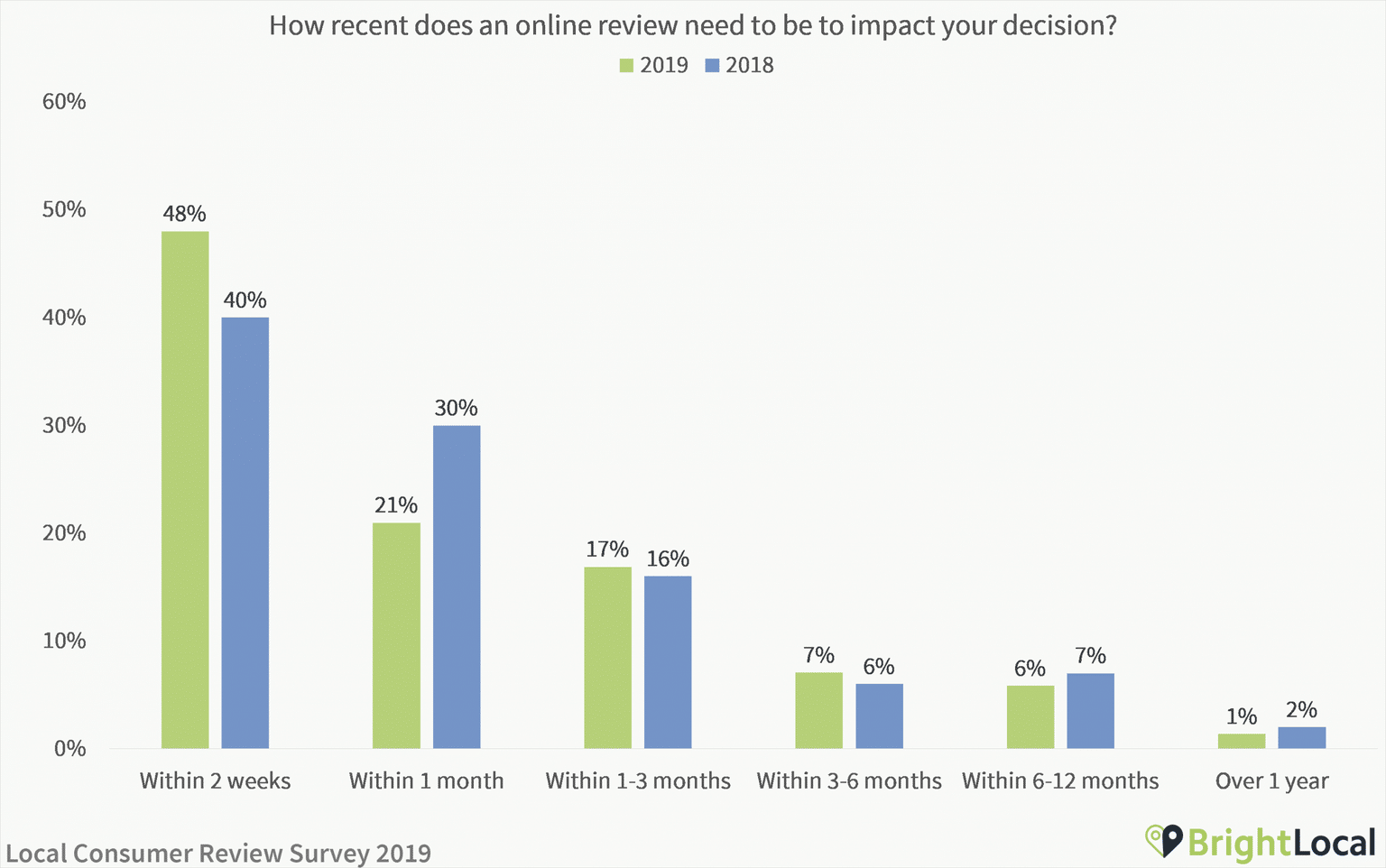
Your business should be present wherever your customers are
3. Diverse reviews. Niche review sites are just as important as general sites.
Why? Because customers use them.
Sophisticated customers tend to gravitate towards specialty review sites that are focused on a particular topic or industry. Healthcare patients prefer a niche platform like ZocDoc and HealthGrades. Foodies rely on platforms like Zomato and OpenTable.
Savvy businesses use a mix of general and niche review sites, prioritizing the ones that deliver the greatest return on investment.
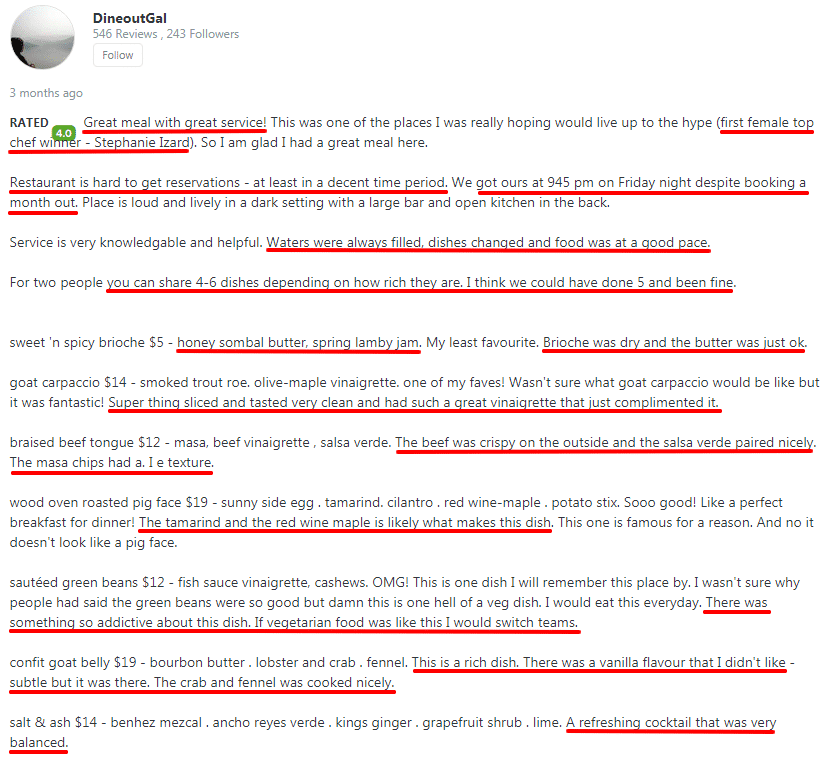
These three areas provide you with a high-level view of the details you’ll need for your review management portfolio. That’s great and all, but it doesn’t really tell you where to start. Okay, where do you start?
Step #1: Audit your review portfolio
Remember the saying “what gets measured gets done?“
That’s also true here.
If your review portfolio is less than ideal, you’re losing customers. Remember the Moz research I referenced in a previous post about the ROI of online review management?
Here’s a quick recap.
Moz found aggregate review listings in search engines had a huge effect on traffic, conversions and revenue. If your business had…
- One negative review listing = 21.9% less customers
- Two negative review listings = 44.1% less customers
- Three negative review listings = 59.2% less customers
- Four negative review listings = 69.9% less customers
The effect that negative (or no) reviews can have on your business is devastating.
You need to know.
Auditing your review portfolio gives you direction, showing you what your first steps should be and how many steps you’ll need to take to reverse your problem.
What you’ll need to audit your review portfolio:
1. A list of review sites that are relevant to your business and industry
2. A list of the completed business profiles (on each site) claimed by your business
3. Your aggregate star rating (on each site)
4. Whether you’re responding to customer feedback (and where)
Advanced (but optional) to-dos:
5. Website conversion rate (segmented by traffic source)
6. Revenue (segmented by traffic source)
7. Average order values (segmented by traffic source)
8. Repeat purchase metrics (segmented by traffic source)
These metrics give you a complete picture of your situation as it stands today. Gathering this information gives you the data you need to set clear goals and objectives.
What if you don’t have these?
What if you weren’t aware that you needed to track these details at all?
Not to worry.
The first four items should be easy enough to collect. The advanced to-dos are details you can track in the future. At this point, you should have some data to work with.
What do you do with it?
Step #2: Skip the plan, start working instead
You need a shotgun approach, at first.
You should already have a list of review sites that are relevant to your business and industry. This means you’re ready to begin working on your review portfolio.
1. Find, create, or claim your company profile on each of the review sites on your list
2. Build, fix, or edit all of the existing citations in your list
3. Ask customers to write a review for each of the profiles in your list
Find, create, or claim your company profile on each of the review sites on your list
Review listings give customers a chance to find answers to their questions and objections. That’s why it’s so important to claim your listings on review sites.
Seems obvious, doesn’t it?
You’d be surprised at the number of businesses that don’t claim their listings.
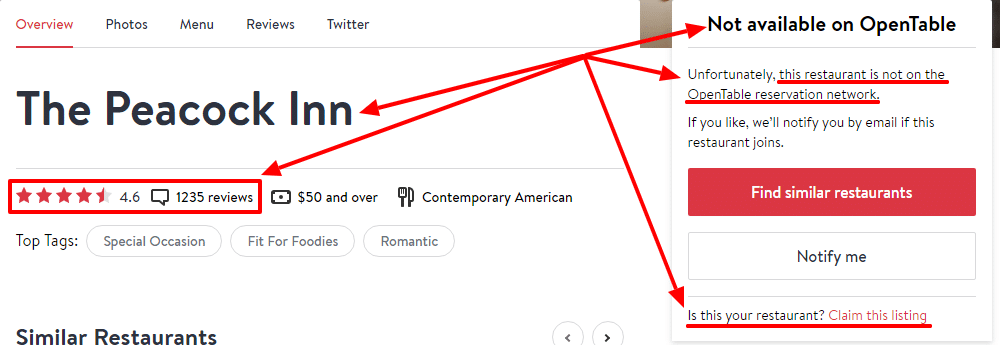
The business in our example, The Peacock Inn, has more than 1235 reviews. Most of their customers are happy, but they have a significant amount of one and two-star reviews.
If they claimed their profile they’d have a chance to respond to customers (privately in this case) who’ve posted negative reviews.
Okay.
What specific profiles are you looking for?
- Mainstream listings. Google, Facebook and Yelp
- Directory listings. CitySearch, YP, Manta, Angie's List
- Local listings. BBB, Tupalo, Judy's Book
- Social listings. LinkedIn, Foursquare, Facebook, Nextdoor
- Niche listings. Avvo, ZocDoc, Zomato, OpenTable, TripAdvisor
The online review site ecosystem has become pretty massive. Just take a look at the many industry specific review sites that can be integrated with Grade.us.
Claim all your listings? Good.
Now you’re ready to…
Build, fix, or edit all of the existing citations in your list
What’s a citation and why do you need it? Moz breaks it down for us:
“A local citation is any online mention of the name, address, and phone number for a local business. Citations can occur on local business directories, on websites and apps, and on social platforms. Citations help Internet users to discover local businesses and can also impact local search engine rankings. Local businesses can actively manage many citations to ensure data accuracy.“
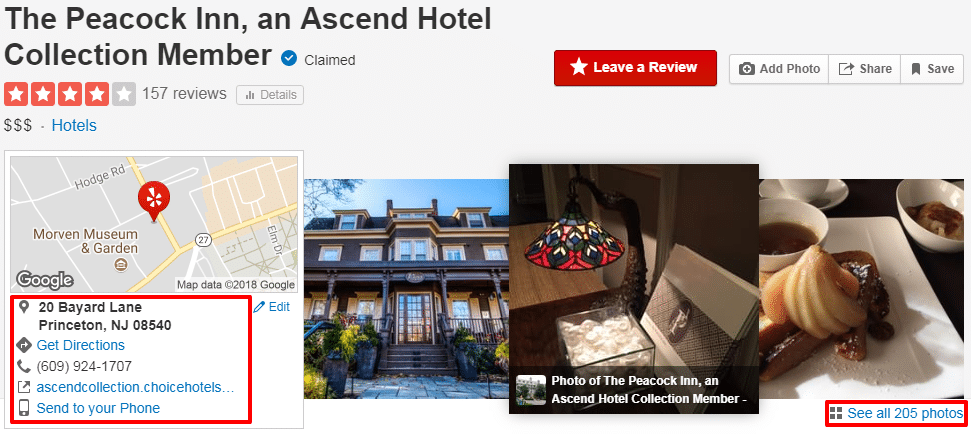
Your name, address and phone number (NAP) are the core components of a citation. But there’s actually more that’s included in your citation:
- Business categories
- Hours of operation
- Driving directions
- Business description
- Images
- Videos
- Payment methods accepted
- Geo-coordinates
- Reviews
- Owner responses
- Taglines
- Links to social media channels
- Email addresses
- Fax numbers
- Alternate phone numbers
- Attributes
You want to make sure that your citations are accurate, updated and consistent. It sounds simple enough but it’s often quite difficult to do.
That’s difficult when you’re dealing with factors like franchises. Or organizations with multiple brands (in the same location). What about organizations with multiple locations or numerous phone numbers?
That complicates things, doesn’t it?
Customers expect you to find, fix and manage these citation issues ahead of time.
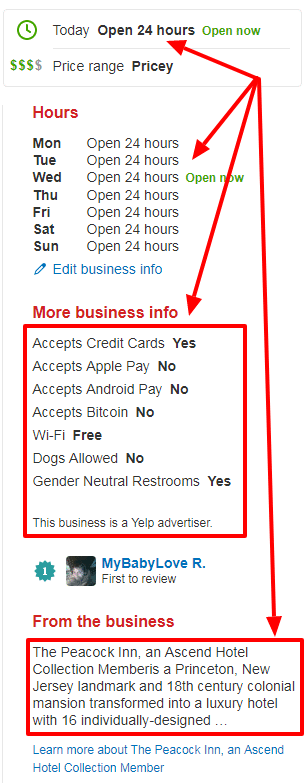
Ask customers to write a review for each of the profiles in your list
It can be difficult to ask for feedback.
Maybe you’re not sure how to go about structuring your review request. If customers are just satisfied (instead of delighted) they may not know what to say.
It’s still important to ask.
Why?
Because they’re more likely to say yes. When asked, 68% of consumers left a local business review out of 74% total.
Okay.
How do you ask and when?
It all depends on you. A face-to-face request is 34 times more effective than an email request. Does that mean your written review requests are ineffective?
Absolutely not.
Research shows asking for a favor boosts customer response. It increases our odds of getting more favors in the future. So how do we approach this?
We use templates.
- If you’re making a face-to-face request, these review request scripts can show you how to ask.
- If you’re sending a written request you can get started with these email review request templates.
- Use these templates to convince an unhappy customer to write a five-star review.
- Want a review request playbook for your service business? Look no further.
Work to consistently request reviews from your ideal customers. You want to target each of the review sites on your list until you have data. Once you have data you’re ready to…
Step #3: Prioritize and plan your reviews
Remember earlier?
When I said you needed diversity in your review portfolio? That’s still the case, but diversity needs another component if it’s going to work hard for you.
Prioritization.
Thanks to the Pareto distribution, also known as the 80/20 rule, we know that roughly 20% of the review sites in your portfolio will produce 80% of your overall results.
This requires caution.
Does this mean you can focus on the review sites in your top 20% and safely ignore the rest? You can, but that’s not a great plan.
Here’s why.
Mainstream sites – Google, Facebook, Yelp – these sites attract a massive amount of reviews from mainstream customers. These reviews can be generic or specific, helpful or unhelpful.
It can be hit or miss.
Mainstream sites attract a massive amount of attention and traffic, but they come with a small downside. A longer sales/conversion cycle.
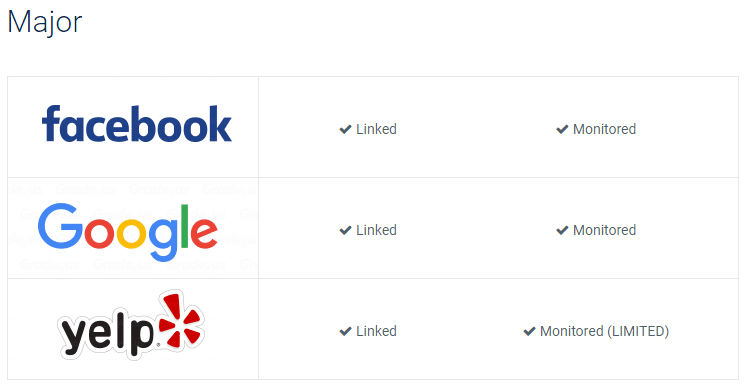
Niche sites are different.
They’re focused on a specific industry, topic or specialty.
Even better, the prospects on niche review sites are, more often than not, sales-ready. They’re hyper-qualified, sophisticated buyers who know their way around a particular topic, product or service.
This also makes them a bit more demanding.
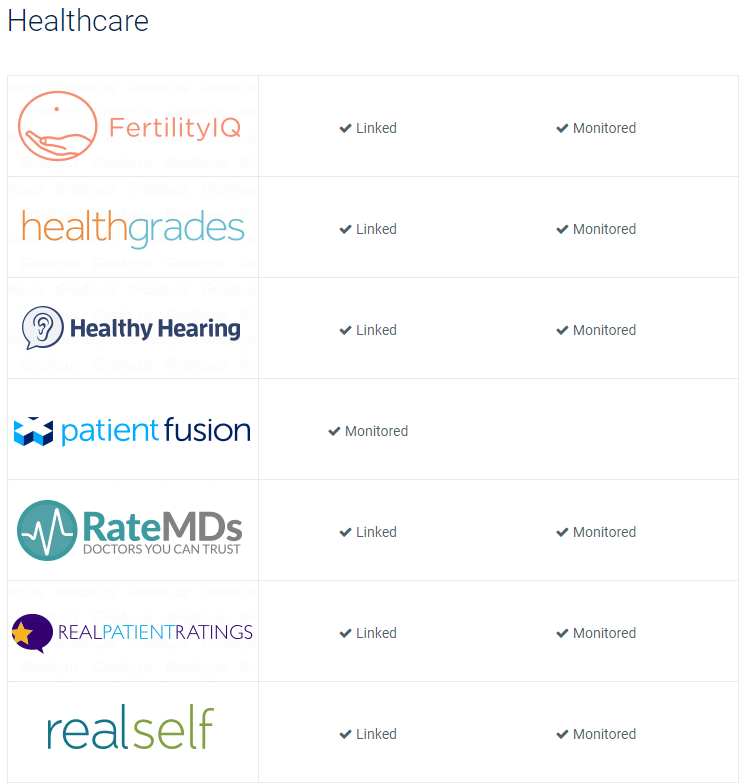
Zagat, Avvo, HealthGrades, ZocDoc, Houzz and Angie’s List are all great examples of niche sites that are focused on a specific industry, topic or specialty.
So which one you choose?
Do you take the mainstream approach and focus on the big three (e.g. Google, Facebook and Yelp)? Or do you focus your attention on niche sites that are specialized, targeted and filled with more sales-ready customers?
Savvy marketers focus on both.
Mainstream review sites give you the attention, traffic and revenue your business needs. You’re able to attract the volume of customers you want. With niche review sites, it’s easier to attract the quality customers you want.
If you already have a review portfolio and the segmented by traffic source data from step one, you have a clear path to follow. But even if you don’t have that data, it’s important to create a diverse review portfolio. One that isn’t top-heavy (e.g. all your reviews are in Google) or overly dependent on any one particular source.
What about prioritization?
How do you identify the review sites that deserve more of your attention?
You use your metrics.
Initially, you work with all of your target review sites giving each of them an equal amount of airtime. Then, you prioritize using performance metrics (e.g. ROI, ROAS, conversion rate, etc.).
Use the right metrics to identify top performers
Your review management campaign has three components.
1. Attraction. The review sites that attract a consistent or significant amount of customer attention/traffic.
2. Conversion. Reviews and review sites that convert customers, whatever your conversion goal may be. Could be a landing page visit, product purchase, appointments set, etc.
3. Consumption. Review sites that create attraction + conversion + consumption. Consumption, in this case, refers to customers using your product or service. The more they consume, the more they buy.
Once you’ve identified your top-performing review sites you split your attention accordingly. Divert more of your time and budget to your top performers.
Then rinse and repeat.
Now that we have the basics down, here are 18 more strategies you can use to get more reviews, quickly.
1. Create more review profiles
Do you know what a potential customer will do next? Can you tell me where an individual customer will go to authenticate your business?
You can’t, can you?
Well you know what? Neither can I. None of us can in fact.
Here’s why that matters.
Let’s say you’ve run a brilliant ad campaign. You’re getting a significant amount of traffic coming to your business. Your prospects are open to buying, but they’re looking for something.
They’re looking for reviews.
It’s very, very common for businesses to focus on a few review profiles. Most businesses focus on their big three. For attorneys that could be Google Reviews, Yelp and Avvo. It could be Google Reviews, Facebook Recommendations and Yelp for restaurants.
Why bother?
The 80/20 rule tells us that 80 percent of your outcomes come from 20 percent of your profiles. That’s true. But this isn’t immediately about traffic.
It’s about domination.
As far as Google is concerned, these review sites have a significant amount of clout. They’re viewed as trustworthy and compelling. If you dominate the search results, you dominate the conversation. Dominate the conversation and you’re suddenly part of the 20 percent that receives 80 percent of the five-star reviews in your industry/locale.
This is what you want, right?
So here’s what you do. You focus 80 percent of your effort on your mainstays, the review platforms you know customers use the most. But you spend 20 percent of your time building up the rest of your relevant profiles.
Why?
So you can dominate the customer/provider conversation.
2. Create review "tripwires"
If you want a steady stream of five-star reviews you’ll need a review management campaign. This isn’t enough though. You’ll need a set of tripwires.
You’ll need listening tools.
- Social media monitoring software like Traject Social
- Tools like Moz, SEMRush, AuthorityLabs, and Google Alerts to monitor the search results
- Comprehensive online review management tools like Grade.us to manage customer reviews
You’re looking to maintain a 5 to 1 ratio. Five positive (four stars or above) reviews for every negative review you receive. This means you’ll need to focus your attention on immediately attracting more positive reviews when a negative review comes in.
This is how you swim against the tide.
When a negative review comes in you immediately shift your attention to attracting five new, positive reviews to counteract the loss of traffic and conversions.
3. Rephrase "the review request"
How you ask is almost as important as the ask itself. There are lots of ways to make a review request. There’s a certain nuance to asking appropriately.
Here are a few:
- Request feedback (see below)
- The salvation request (Asking customers to counter a negative review)
- Concern request (Have you run into any problem spots with us? Where can we improve?)
- Prestige approach (We’re reaching out to the top 3% of our customers, that’s you.)
- Earnings request (Hi customer, what can we do to earn a five-star review from you?)
- Direct approach (Would you be willing to write a review for us?)
- Faults request (What’s the most frustrating part about working with us?)
- Results request (Last mo. we increased your (gross revenue) by (20%). This mo. the increase is projected at (40%). Is there anything else we can do to earn a review?)
- Gratitude approach (Hi customer, I’m the GM at our restaurant. I wanted to thank you for stopping by today. How was your visit with us?)
- Contrast approach (What’s the best/worst thing about working with us?)
How you ask has more to do with how you initiate the conversation, not how you end it. Inexperienced sellers make the mistake of becoming fixated on the review.
They use the wrong request and, as a result, response rates are less than stellar.
4. Ask for reviews at the perfect time
Research shows the best time to ask for reviews is immediately after a conversion or transaction. You know, right after your customer signs up for something or gives you money.
You want the details to be:
- Fresh and clear in your customer’s mind. Wait too long and their memory begins to deteriorate.
- On the tail end of a conversion.
- After you’ve done something amazing or wonderful.
- When your customer is happy as a result of something good you did for them.
Reasonable right?
You’ll want to position your request so as to increase your likelihood of success. Your timing is absolutely crucial here.
5. Change the way you ask for a review
Research shows face-to-face requests are 34 times more effective than emailed requests. Email requests are still incredibly effective as 70% of customers will leave a review when asked via text, phone, email or personal requests.
What does this mean?
It means there is a stacking order. An ideal way to request reviews. This sounds impractical. There’s no way you can make a face-to-face review request with each and every customer.
Actually, there is.
You can do it with video. Video gives you the trust that comes with face-to-face interactions and the scale to grow with it. Long story short, you can use video/video ads to make more face-to-face requests.
Want to maximize your results? Follow these steps:
- Personalize tastefully, wherever and whenever you can.
- Don’t ruin the relationship by spamming. Remarket with care.
- Focus on one message, your request for a review. Don’t combine it with any other message.
- Give customers just enough time to evaluate your product or service. No more, no less.
- Use a familiar face for your face-to-face ask.
There’s a way to make this even more powerful.
Combine the ask.
Use in-person, phone, video, text and email to make your requests. Layer these communication channels (using the criteria above as a guide). You’ll find your review request response rates go through the roof!
6. Embed reviews on your website
The Grade.us review stream plugin enables you to display reviews from any platform or service on your website. You can also embed tweets, Yelp reviews and Facebook recommendations on your web pages. Post these reviews on your sales and confirmation pages.
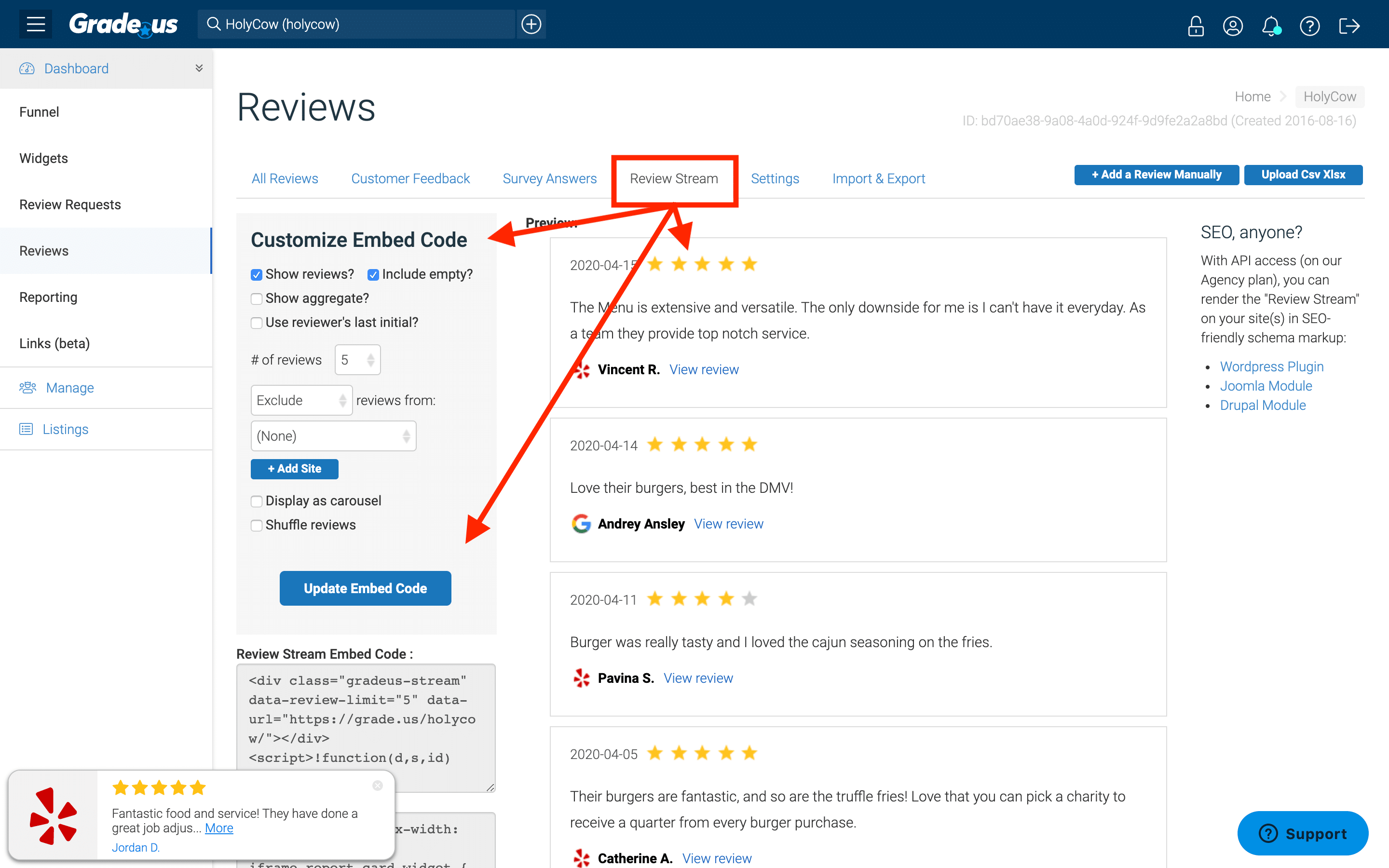
This is an important step.
This primes your new customers, using implied social pressure as a gentle persuasion mechanism to get more reviews.
7. Share positive and negative reviews on social media
You can use social media management tools like Traject Social to track specific keywords, mentions, and requests from your target audience.
I need a good landscaper that doesn’t charge an arm and a leg...send some recommendations please.
— LaLa (@Lalaa_tx) April 6, 2020
When prospects make a request on social media sites, you step in with three distinct ingredients.
1. A strong value proposition
2. An irresistible offer
3. An outstanding review portfolio
You’ll need these ingredients to overcome the initial resistance prospects have. Look for opportunities to give and serve, to treat these prospects as if they’re already your customer. Then, once you’ve won the sale, knock their socks off. Go above and beyond.
Finally, use the feedback interview (#18) to attract reviews from your social media customers.
8. Create an autoresponder sequence
Text and email autoresponder sequences are effective ways to utilize the online reviews you already have! These autoresponder sequences can be referred to directly or indirectly. They can be included in the autoresponder sequences itself or simply information that’s pointed to.
You can use these autoresponder sequences for a variety of options.
- Sending emails and/or text messages to customers who are already in your review funnel, using existing reviews to attract more reviews.
- Matching products and services in your autoresponder sequence to reviews. Any product or service you pitch has a complement of reviews to go with it.
- Using a text and email autoresponder sequence to handle negative reviews and bad press.
- Encouraging subscribers to join another list.
- Including reviews as part of a sales autoresponder sequence.
- Lead with a text message autoresponder sequence then, once customers respond, use triggering events (see below) and automation to transition to email and social media.
9. Surprise customers with routing extras
This strategy relies on the law of reciprocity. We all know what reciprocity is. It’s a social norm where we respond to a positive action with a positive action of our own.
How do you ambush customers?
You make it a rule to lavish them with positive experiences and inexpensive extras. A random thank you card here, a small surprise gift on their next visit, etc. You’re looking for ways to show customers you genuinely value their relationship.
Genuine is the keyword.
If you’re using the strategy to extract reviews, your customers will notice. Which obviously means the strategy will backfire horribly. Your customers know when they’re being manipulated.
So be genuine.
Show customers you care by prioritizing your responses around their happiness.
Like this:
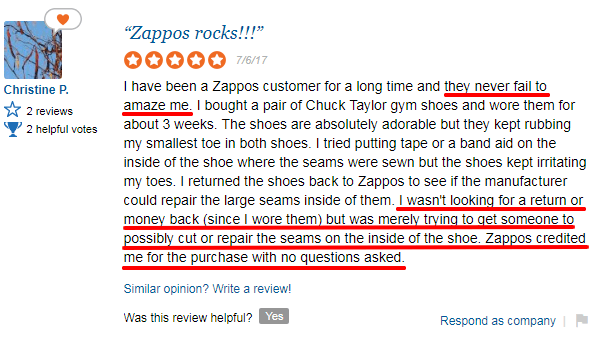
Here’s the thing.
You’ll want to be unpredictable. Predatory customers thrive on routine. An unpredictable strategy is more difficult to manipulate.
10. Train employees to ask for reviews
Your employees don’t know how to ask for reviews. They don’t know what to say. They’re not entirely sure when or how to say it. What’s worse, there doesn’t seem to be a whole lot of direct upside for employees.
Employee insights and practical suggestions can change that.
But they’re still going to need training. Use this guide to train your employees properly. Show them how to make the Matthew effect work for them. With this guide, you’ll be able to give them the framework and scripts they need to earn more reviews.
If you train your employees to neglect the incentives you won’t get very far that’s because you’ll need to…
11. Give employees an incentive
Brian Paterson at Marketing Land suggested using the tip strategy get reviews.
Here’s how it works.
“The ‘tip’ trick is one of those review growth hacks that can work really great in particular industries. The strategy is that someone who has spent a lot of time with a customer then asks for a review, but throws in the kicker of, “If you had a good experience and include my first name in the review, the company gives me a $10 tip.”
This little ‘sweetener’ gives a customer the extra incentive to leave an online review, particularly if he or she had a good experience.“
If you’d like to take the tip strategy further, here’s a comprehensive guide you can use to create a review request incentive program for your employees.
It covers advanced strategies like the bonus pool, impromptu contests, conditional profit-sharing and more.
12. Leave reviews everywhere
The Matthew effect has a significant impact on online reviews. This effect is sometimes summarized by the adage, “The rich get richer and the poor get poorer.” Research backs this up, showing that brands with strong review portfolios attract a disproportionate amount of traffic, conversions, leads and sales from their customers.
Leaving reviews everywhere produces this effect, boosting the number of reviews you’re able to attract from incoming customers.
You can share customer reviews via:
- Screenshots on your social media profiles (e.g. LinkedIn and Facebook status updates)
- Your website embedded reviews
- Your search and display advertising
- Remarketing, retargeting, and custom audiences
- Forum posts as a signature at the bottom of each post
- Your content upgrades, e-books, downloads and lead magnets
- Your email list, sales, and confirmation pages
- Guest posts provided that it’s relevant and contextually appropriate to do so
- Proposals and sales documents
- On-hold phone messages
- Demo Reels
- Media intro/outros (e.g. podcast, interviews, videos, audiobooks, etc.)
Sprinkle reviews everywhere you can. Follow these helpful guidelines and you’ll maximize results you receive from this strategy:
- Share don’t spam.
- Whenever possible, provide a link to the original review.
- Let customers brag for you, avoid doing it yourself.
- Be consistent and share often.
- Be balanced with your sharing. Share the good, bad, and the ugly.
- When you share negative reviews, show how you fixed the problem.
- Be kind, be helpful or you’ll soon be gone.
These strategies are simple, straightforward and easy to follow.
13. Advertise your best (and worst) reviews to existing customers
There are two ways to use this strategy.
1. Advertise your five-star reviews, with some three and four-star review sprinkled in, to prospects.
2. Use the challenge review (see below) with existing (happy) customers to counteract negative reviews.
This strategy is platform specific.
If you’re running ads on yelp you’ll want to use option #1. These ads are geared specifically towards prospective customers. In fact, most of the review ads you run will be geared towards prospects.
What about option #2?
You want to use the challenge review with custom audiences and remarketing ads. Upload your list of customers (via CSV or excel) or via your pixel tracking code. You need to identify a specific and measurable metric you can use to identify these customer evangelists.
- Number of purchases
- Size of purchases
- Age of the relationship
- Average order values
Anything that identifies the customers in your database who already like you. As a general rule of thumb you want to use the following methodology to advertise reviews:
- Cold traffic = advertise five and four-star reviews
- Hot traffic (i.e. your best customers) = one and two-star reviews
Why would you send negative reviews to your best customers? You’re rallying the troops. Your best customers know who you are. They’ll recognize an unreasonable review when they see it. And they’ll come to your defense if you ask.
Advertise your reviews, then request more reviews.
14. Use the "challenge review"
The strategy is all about building consensus. You want to know what your customers think about a particular topic or idea. Let’s say you receive a negative review from an unhappy customer. They’re misguided and confused about the guarantee you offer.
You’ve tried to explain in your response but they’re unwilling to listen.
Enter the challenge review.
The challenge review motivates your tribe to take action on a particular review.
Here’s how you use this strategy to get more reviews.
Hi [Customer Name],
This is [Your Name]. I’m the GM at [business]. An unhappy customer says our service is [customer quote here].
You’re one of our best customers and we want to know, what do you think? Would you share your honest experience with us?
[Review Funnel Link][Your Name]See what I did there?
You’ll want to use the strategy with customers who love your business and are willing to help out. You know the ones. This strategy does not work well with neutral and apathetic customers.
15. Convert bad reviews with "review redemption"
It’s a scary strategy you can use to get amazing, five-star reviews, from previously unhappy customers.
Here’s how you do it.
1. Create a list of negative reviews. You’re looking for customers with a legitimate reason for their negative review.
2. Remove unhealthy reviewers. Ignore any reviewers who are abusive, ragers, sadistic or trolling. Look for sincerely unhappy customers who feel let down.
3. Create a redemption offer to entice these unhappy customers. If you’re running a ski resort, you can offer unhappy customers a free 10-day pass, with accommodations good for 10 people.
4. Pitch your unhappy customers. Reach out to your list of qualified customers. You should have their contact information on file. Make it abundantly clear that (a.) you took their review to heart and you’ve made some dramatic (positive) changes based on their feedback, (b.) you’d like to make things right, and (c.) you’re looking for an updated review (positive or negative).
5. Make their experience unforgettable. Roll out the red carpet, ensure your staff is on their very best behavior. Do everything in your power to restore the relationship. Work to ensure your customers are happy.
16. Use the "feedback interview"
The feedback interview review request is a customer-led response technique that’s used to get reviews. It relies on nuance and uses the specific details of your customer’s situation to request feedback.
Here’s how it works.
You recognize a triggering event (e.g. an award you’ve won, a customer complaint, free trial expiring, unsigned proposal, etc.). Next, you create a response requesting feedback that’s specifically tied to your triggering event.
Here are a few examples.
Triggering event: you won an award
Hi [Customer Name],
[Your Name] here. [Business] was just voted #1 in [company award]. That’s nice and all, but I’m more interested in what you think about us.Would you be willing to share your feedback?
[Review Funnel Link][Your Name]Triggering event: customer places an order
Hi [Customer Name],
[Your Name] from [business] here. Thanks for your recent order. Your items are on their way!Can I ask a tiny favor?
How did we do? We want to know if we exceeded or missed your expectations. Would you be willing to share your feedback with us?
[Review Funnel Link][Your Name]Triggering event: client project launch
Hi [Customer Name],
It’s [Your Name] from [Company Name]. Quick question for you.
On a scale of 1 – 5, how likely are you to recommend us? We’re looking for brutally honest feedback.
Would you be willing to answer these five questions?
[Review Funnel Link][Your Name]If you’re in B2B sales, this strategy is the perfect way to get amazing reviews.
Here’s how it works.
1. Go through your list of customers. You’re looking for customers who: (a.) Haven’t written a review for your product or service yet, and (b.) have a product or service you need.
2. Buy your customer’s product or service. Use it as intended. If your experience is positive, write a positive review. If your experience is negative, share your feedback with them directly. Then, once they’ve fixed the problem, write a positive review.
3. Send your customer a review request. Ask them for their feedback on your product or service. This works best if you send your request to the same point of contact in step two.
Here’s why this strategy works.
You guessed it. The law of reciprocity. When you share your review with your customers (and you give them permission to use your name and website address), you gain a link back to your site. You also earn a high-quality review from a motivated customer.
It’s a win-win all around.
17. Use the "poster boy" strategy
Can you see what’s happening?
If you know what you’re doing, anything and everything is a triggering event! Each triggering event is a chance for you to reach out to customers personally, request their honest feedback and convert their feedback to a review.
Relevance is an easy way to break the ice with customers.
18. Use the prestige ask
Are customers more willing to write a positive review if they feel they’re part of a special or prestigious group?
Absolutely!
Here’s how you use the prestige ask to get reviews.
Hi [Customer Name],
[Your Name] here. I’m reaching out to the top 3% of our clients (that’s you :). Would you be willing to answer a few questions? Takes only 4 min.[Review Funnel Link].No worries if you can’t.
You’re amazing!
[Your Name]What if your customers aren’t prestigious? There’s always something (true) you can use to make your customers feel special and appreciated. Here’s a short list of triggers you can use.
- Their birthday
- Your birthday
- Their sign-up anniversary
- Their upgrade anniversary
- Repeat purchases
- Rare purchases (i.e. you’re one of only 30 people to stay in our penthouse!)
- Length of the relationship (i.e. you’ve been with us for 13 years, your opinion carries more weight)
- Quality of the relationship
- Results/outcomes achieved (i.e. we’re so happy we could get you in and out in record time!)
Here’s the secret to this strategy. It’s genuine scarcity and an abundance of gratitude. If your customers are part of a rare group and you’re adequately thankful they’re far more likely to respond well.
You know how to get business reviews, right?
It seems like a silly question to ask.
You provide customers with amazing support. You ask for a review, customers give you five-stars, easy peasy.
As we’ve seen, there’s a right and wrong way to get business reviews. The question “do you know how to get business reviews” is a complex one. Inexperienced businesses think it’s all about the ask.
You’re a sophisticated marketer.
You know how to get business reviews. You know it’s about having a review management strategy in place. An approach that consistently attracts top reviews from happy and satisfied customers.
Because getting business reviews is simple if you have the right strategy in place.









